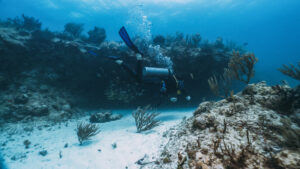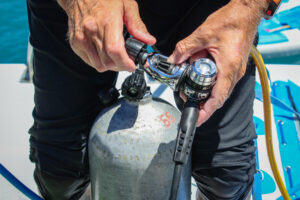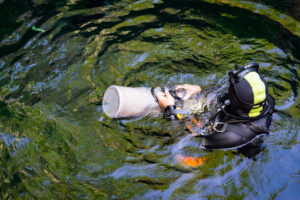What is an Electro Galvanic Fuel Cell (EGFC)?
An electro galvanic fuel cell (EGFC) is a type of electrochemical sensor used extensively in scuba diving equipment for oxygen monitoring. It operates based on the principle of generating an electrical current through a chemical reaction between oxygen and a fuel, typically a metal like lead or zinc. The current produced is directly proportional to the amount of oxygen present, making EGFCs crucial for ensuring safe breathing gas mixtures in underwater environments. This entry delves into the fundamental principles, historical development, technical specifications, applications in scuba diving, maintenance practices, and regulatory considerations of electro galvanic fuel cells.
Basic Principles of Electro Galvanic Fuel Cells
Electro galvanic fuel cells function through an electrochemical reaction where a fuel, usually a metal, reacts with oxygen. The typical components of an EGFC include two electrodes (an anode and a cathode) and an electrolyte. The anode is commonly made from lead or zinc, while the cathode is usually made from a material like platinum that facilitates the reduction of oxygen. The electrolyte, often a potassium hydroxide solution, enables the ionic transfer between the electrodes.
When oxygen comes into contact with the cathode, it gets reduced, gaining electrons from the circuit. This process generates hydroxide ions (OH-), which then travel through the electrolyte to the anode. At the anode, these hydroxide ions react with the metal, oxidizing it and releasing electrons back into the circuit. This flow of electrons creates an electrical current, the magnitude of which is proportional to the amount of oxygen present.
The voltage produced by this reaction is relatively small, typically in the range of 0.7 to 1.0 volts. However, it is sufficient to be measured accurately by electronic circuits within scuba diving equipment. The output from the EGFC is used to provide real-time oxygen readings, ensuring that the diver’s breathing gas mixture is within safe limits.
History and Development of EGFCs
The concept of galvanic cells dates back to the 18th century with Luigi Galvani and Alessandro Volta, pioneers in the study of bioelectricity and electrochemistry. Their work laid the groundwork for the development of electrochemical cells. The specific application of these principles to create oxygen sensors emerged much later, driven by the need for precise and reliable oxygen monitoring in various industries, including diving.
The first practical use of EGFCs in scuba diving can be traced back to the mid-20th century, coinciding with advancements in diving technology and a greater understanding of underwater physiology. Early oxygen sensors were rudimentary and often unreliable, but they represented a significant step forward in ensuring diver safety. Over the decades, improvements in materials, manufacturing techniques, and electronics have greatly enhanced the performance and reliability of EGFCs.
By the 1970s and 1980s, EGFCs had become a standard component in rebreathers and dive computers. These advancements allowed for more accurate and continuous monitoring of oxygen levels, reducing the risk of hypoxia (low oxygen levels) and hyperoxia (high oxygen levels). The integration of EGFCs into modern diving equipment is a testament to their importance and effectiveness.
Technical Specifications of EGFCs
Electro galvanic fuel cells come in various sizes and configurations, tailored to specific applications within scuba diving equipment. The typical EGFC used in diving gear is compact, often cylindrical, and designed to fit into the oxygen sensor housing of rebreathers and dive computers. These cells can vary in size, but they generally weigh between 50 grams (1.76 ounces) and 200 grams (7.05 ounces).
The output of an EGFC is characterized by its voltage and current. A standard EGFC produces a voltage in the range of 0.7 to 1.0 volts and can generate a current of up to a few milliamperes, depending on the concentration of oxygen. The sensitivity of these cells is crucial, as they must detect oxygen levels with high precision to ensure the safety of the diver.
Material choices for the electrodes and electrolyte significantly affect the performance and longevity of the cell. Platinum is commonly used for the cathode due to its catalytic properties and resistance to corrosion. The anode is typically made from lead or zinc, materials that offer a good balance between reactivity and durability. The electrolyte, usually a concentrated solution of potassium hydroxide, ensures efficient ionic conductivity and stability over a wide range of temperatures and pressures.
Applications in Scuba Diving
In scuba diving, EGFCs are primarily used in rebreathers and dive computers to monitor oxygen levels. Rebreathers recycle the breathing gas by removing carbon dioxide and replenishing oxygen, allowing divers to stay underwater longer without the need for large air tanks. Accurate oxygen monitoring is essential in these systems to maintain a safe breathing gas mixture.
The use of EGFCs in rebreathers involves placing the sensor in the breathing loop, where it continuously measures the partial pressure of oxygen. The data collected by the EGFC is sent to a control unit that adjusts the injection of oxygen to maintain the desired setpoint. This automatic regulation helps prevent hypoxia and hyperoxia, conditions that can have severe or fatal consequences for divers.
Dive computers equipped with EGFCs provide real-time oxygen readings and alerts. These devices are crucial for planning and executing dives, especially when using mixed gases like nitrox or trimix. The EGFC ensures that the oxygen content remains within safe limits, allowing divers to focus on their underwater activities without constantly worrying about their breathing gas.
Maintenance and Handling
Proper maintenance and handling of EGFCs are vital to ensure their accuracy and longevity. Regular calibration is necessary to maintain the sensor’s precision. Calibration involves exposing the EGFC to a known concentration of oxygen and adjusting the output to match the expected value. This process compensates for any drift in the sensor’s performance over time.
Handling EGFCs requires care to avoid damage and contamination. The sensors should be stored in a dry, cool environment to prevent degradation of the electrolyte and electrodes. It’s essential to avoid exposure to high temperatures and corrosive substances, as these can compromise the cell’s integrity and functionality.
Common issues with EGFCs include sensor drift, electrolyte leakage, and electrode degradation. Regular inspection and maintenance can help identify and address these problems before they affect the sensor’s performance. Replacing the EGFC at recommended intervals, typically every 12 to 24 months, ensures continued reliability and accuracy in oxygen monitoring.
Regulatory and Environmental Considerations
The use of EGFCs in scuba diving equipment is subject to various regulatory standards to ensure safety and performance. Organizations like the International Organization for Standardization (ISO) and the American National Standards Institute (ANSI) provide guidelines for the design, testing, and certification of oxygen sensors. Compliance with these standards is essential for manufacturers and helps build confidence in the safety and reliability of the equipment.
Environmental considerations are also important in the lifecycle of EGFCs. The disposal of used cells must be managed carefully to prevent environmental contamination. Lead and other materials used in EGFCs can be harmful if not disposed of properly. Recycling programs and proper waste management practices are critical to minimize the environmental impact.
Manufacturers are encouraged to use environmentally friendly materials and processes wherever possible. Advances in materials science and manufacturing techniques are continually improving the sustainability of EGFCs. Ensuring that these cells are both effective and environmentally responsible is a key aspect of their ongoing development and use.
Key Takeaways
Electro galvanic fuel cells play a crucial role in ensuring the safety and efficiency of scuba diving by providing accurate oxygen monitoring. Their development and integration into diving equipment have significantly enhanced underwater safety. Understanding their principles, technical specifications, applications, maintenance, and regulatory aspects helps highlight their importance in the diving community. Proper handling and adherence to standards ensure their reliable performance, contributing to safer diving experiences.

















